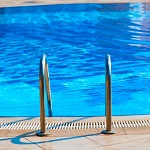
Backwashing Tips for a Smooth-Running Filtration System
Keeping your commercial pool clean is critical. After all, swimming in a cloudy, particle-filled pool is not appealing to swimmers. It can also be dangerous, since opaque water makes it impossible for lifeguards to see to the pool’s bottom and ensure swimmer safety.
Proper filtration is crucial for maintaining good water quality and a healthy pool, notes the World Health Organization (WHO). Not only does effective filtration remove Cryptosporidium oocysts and Giardia cysts, preventing water-borne illnesses, it is also effective against microbes that harbor bacteria such as Legionella.
The key to keeping your pool’s filtration system clean is regular backwashing. Here’s the scoop on how backwashing works, some tips for backwashing efficiently, and how it can save you money.
What’s the principle behind backwashing?
Most pool filters work by pushing water through porous media — often silica sand — to remove organic material. Larger particles get trapped in the filter, while the clean water returns to the pool. Over time, this particulate matter builds up in the filter, making it more difficult for water to flow through. Backwashing flushes away the contaminates caught in the filter by reversing the flow of water through the filter and sending it to waste or out through a hose connected to the pump.
When the filter media is clean, it is easier for water to flow through the filter, and the filter’s gauge pressure is lower. As debris builds up, pressure increases as it becomes more difficult for water to flow through, and high pressure in a filter tank can create a dangerous situation.
How often should I backwash?
That depends on how much use your pool gets, and whether it is surrounded by trees or shrubs that regularly shed leaves and other organic bits. Industry standards generally hold that you should backwash about once a week, or when the filter gauge reads 10 pounds per square inch (psi) higher than “clean” pressure, according to Recreation Management.
Some experts believe this 10 psi “rule of thumb” is due for an update. Rodney McCall, global growth process leader at Pentair, notes in Pool & Spa News that with the growing use of variable-speed pump technology, pools sometimes circulate the water at lower flow rates than previously. As a result, pool managers run the risk of creating a “no-flow” situation (stagnant water) well before the 10 psi threshold is reached. The weaker flow also means that a pool that normally filters water in several hours could end up taking all day — eating up a much larger portion of your energy bill.
The solution, McCall says, lies in installing a flow meter (which most commercial pools have due to health codes). The meter can feed information to a variable-frequency drive, which then adjusts the filter pump to maintain a chosen flow rate through the cycle (a slower speed when the filter is clean, faster when it accumulates contaminates). The result? More efficient filtering and a sizeable savings in energy costs.
For accurate information on how often to backwash your filter, check the manufacturer’s guidelines, or turn to the experts at your pool management company.
How much water do I lose through backwashing?
The backwashing of a typical Olympic-sized pool results in the loss of about 6,300 gallons of water per backwashing cycle, according to Recreation Management. As a result, don’t add chemicals to your water until after you’ve backwashed — otherwise, you’re just throwing money down the drain… literally.
Surprisingly enough, the best way to conserve water during backwashing is to make sure your backwash flow rate is high enough. Insufficient flow can result in more frequent — and less efficient — backwashing.
How do I know whether my backwashing efforts are working?
Once you’ve completed a thorough backwash, your filter system should return to the ideal “clean” pressure differential. If it doesn’t, or if the differential creeps up over time, then your backwashing efforts aren’t as effective as they should be. Other signs of trouble: If you find yourself needing to backwash more frequently without cause (such as a spike in pool attendance, signaling increased use), or if you notice “channeling” in the sand bed of your filter, which indicates that water is not flowing through at a smooth, balanced rate.
At American Pool, we offer a full range of pool maintenance and management services — and can answer any of your questions about backwashing. Get in touch for more information.





